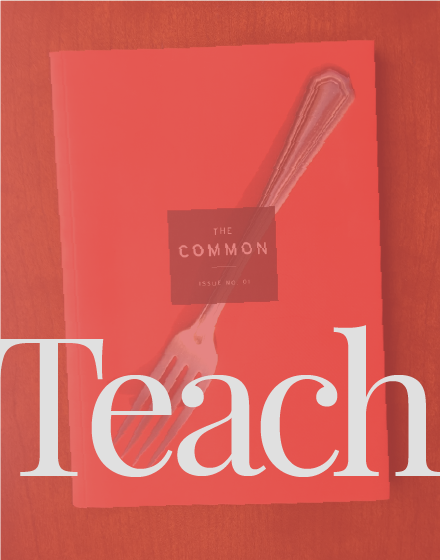Asking students to create homages to several of the works in The Common Issues 01 and 07 promotes a further exploration of the city in which they live. In fact, it requires it of them.
In Issue 01 of The Common, Ted Conover delivers an immersion essay in which he delves into the past and present of a nearly forgotten road near his home in New England. The first prompt of the semester, therefore, compels the students to write their own Conover-esque immersion essay by walking/exploring a street, building, or landmark in their city or town, seeking out written resources on this place, and gathering up the courage to probe living memory. The second prompt, handed out several months later, encourages them to become creative with what they have so far discovered in their town or city by selecting the works that most interested them inThe Common and emulating these.
Prompt 1: “Brown Road (1853-1932)” Essay
To better understand a person, the old cliché encourages you to walk a mile in someone’s shoes. The same holds true for understanding your city or town, though you need not walk a mile. For the sake of this essay, a city block may suffice.
Using Ted Conover’s “Brown Road (1853-1932)” as your structural model, you will write an essay that explores not only the present but also the past of some street, building, or landmark in your town. This will require you to not only document in words and photographs your experience as you move through the location but to also research primary and secondary sources to chronicle and communicate the city/town’s present and past to your reader.
The essay will, therefore, be a hybrid of sorts: the subjective experience that you are having in that place partnered with the objective historical facts that you discover through your research.
Students are graded on the clarity of their prose, the quality of their research, and the creativity they demonstrate.
Prompt 2: Place-based Essay
This assignment will comprise two parts.
For the first part of the assignment, you are going to select either: a) one story, b) one essay, c) three poems, d) a series of photographs, or e) a portfolio of artwork from The Common Issue 01 and/or 07. After having made your selection, you are then going to use whatever sample from that particular genre as your structural guide to write or produce either a) one story, b) one essay, c) three poems, d) a series of photographs, or e) a portfolio of artwork that seeks to emulate the work you chose. This time, however, instead of having the action take place and be particular to Antarctica or Jerusalem or Venice or Chicago, etc., the place in which your homage – an original work – takes place will be the city or town in which you live. Just as with the pieces in The Common, place should inform the characters, setting, and action.
For the second part of this assignment, you are going to write a 500-word essay explaining why you chose the story or essay or poems or photographs or artwork and how your creative effort is a reproduction that embodies and/or engages with this specific place.
Identify a poem (or story or essay) from this issue that uses memory to link a past and present experience with place; write a poem (or story or essay) that functions in a similar way, but draw from your own experience.
Adapted from Julian Zabalbeascoa, Adjunct Instructor, University of Massachusetts Lowell
Feedback from students at University of Massachusetts – Lowell:
“I worked hard to make these pieces reminiscent of The Common poems that inspired me while still being unique. With new senses and perspectives, the poems allowed me to think about the city that I interact with on a daily basis and challenged me to describe it in a new way.”
“While reading this short story it reminded me about when I moved here and the many memories that I had left behind at home. In my college dorm I have little to nothing that reminds me of my life before I moved in, and on occasions I become homesick… I could relate, on a small scale, what Marisa Silver might have felt when she lost everything in the building fire. As she grows older the many material objects that could have reminded her of herself in earlier years are gone… Although my house and all the objects in it are not gone forever, when I am sitting in my small dorm room, it seems that my home is lost and unreachable.”
“In my third and final poem, I wrote about the transition I made from my home to Lowell… I liked the way Yehudit Ben-Zvi Heller wrote in “Otter Cove” about how she took something away from a place presumably to bring it somewhere new…I was very excited to leave my home to start my own life… When I left, I willingly left a lot of myself behind; I brought the necessities and a willingness to succeed and an open mind to college, and so far it has served me well.”
“The next poem I wrote spoke of where I live now, and my home not only in my dorm but also in Lowell. I write about how it’s so different here but that it is now a part of me, and everyone else that lives here. I hope to take all sorts of lessons from Lowell, not only from the university but from the city itself. What I take away from my experiences here will be the deciding factor in that.”
“All of the poems have a common theme of my experiences in the city of Lowell. They each express simple observations and knowledge that has been acquired over the past few months exploring the city. I felt this form of poetry allowed me to express these experiences strongly in such few words and the simple thought of that inspired me to use poetry as my tool.”


